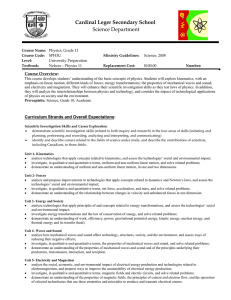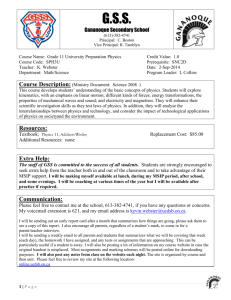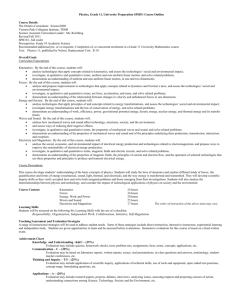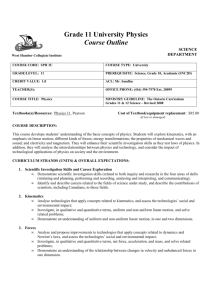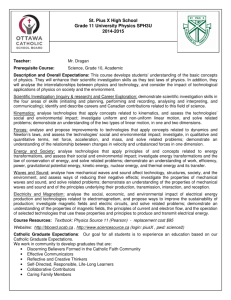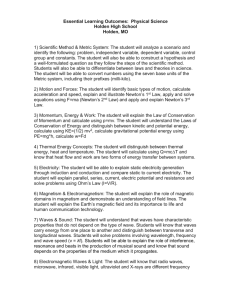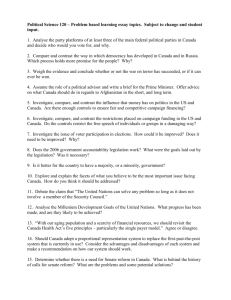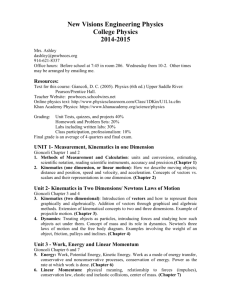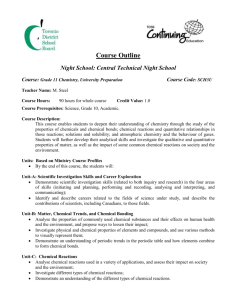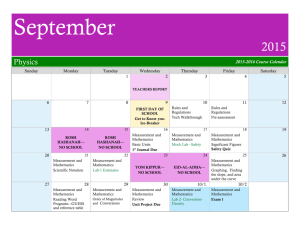Biology, Grade 11, University Preparation (SBI3U)
advertisement
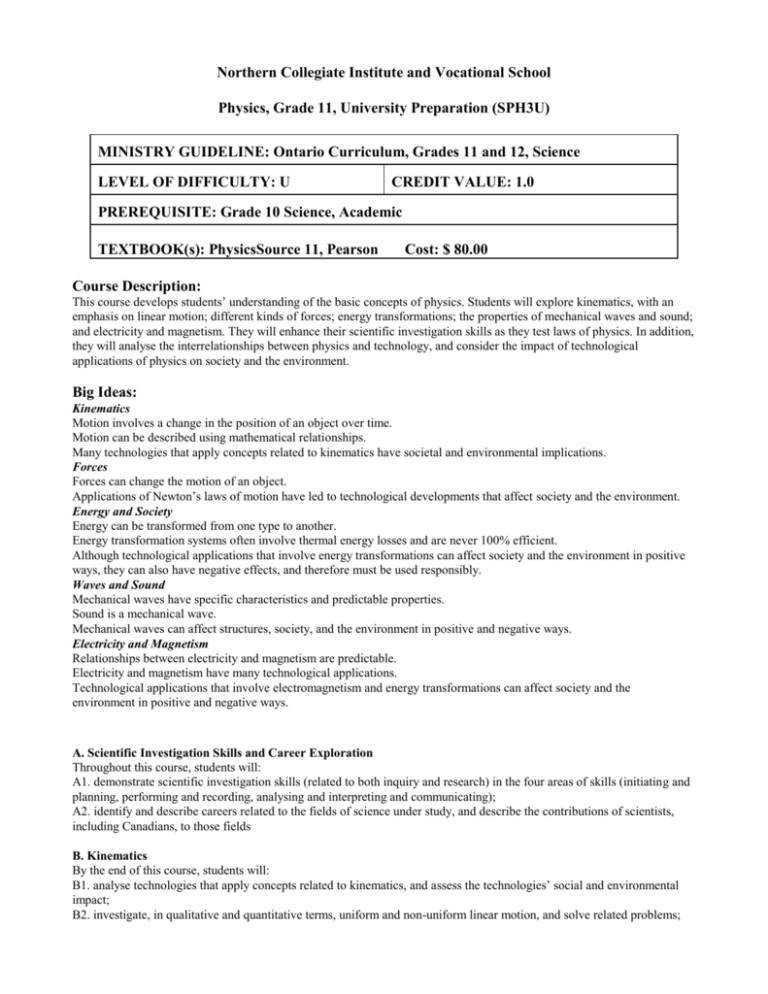
Northern Collegiate Institute and Vocational School Physics, Grade 11, University Preparation (SPH3U) MINISTRY GUIDELINE: Ontario Curriculum, Grades 11 and 12, Science LEVEL OF DIFFICULTY: U CREDIT VALUE: 1.0 PREREQUISITE: Grade 10 Science, Academic TEXTBOOK(s): PhysicsSource 11, Pearson Cost: $ 80.00 Course Description: This course develops students’ understanding of the basic concepts of physics. Students will explore kinematics, with an emphasis on linear motion; different kinds of forces; energy transformations; the properties of mechanical waves and sound; and electricity and magnetism. They will enhance their scientific investigation skills as they test laws of physics. In addition, they will analyse the interrelationships between physics and technology, and consider the impact of technological applications of physics on society and the environment. Big Ideas: Kinematics Motion involves a change in the position of an object over time. Motion can be described using mathematical relationships. Many technologies that apply concepts related to kinematics have societal and environmental implications. Forces Forces can change the motion of an object. Applications of Newton’s laws of motion have led to technological developments that affect society and the environment. Energy and Society Energy can be transformed from one type to another. Energy transformation systems often involve thermal energy losses and are never 100% efficient. Although technological applications that involve energy transformations can affect society and the environment in positive ways, they can also have negative effects, and therefore must be used responsibly. Waves and Sound Mechanical waves have specific characteristics and predictable properties. Sound is a mechanical wave. Mechanical waves can affect structures, society, and the environment in positive and negative ways. Electricity and Magnetism Relationships between electricity and magnetism are predictable. Electricity and magnetism have many technological applications. Technological applications that involve electromagnetism and energy transformations can affect society and the environment in positive and negative ways. A. Scientific Investigation Skills and Career Exploration Throughout this course, students will: A1. demonstrate scientific investigation skills (related to both inquiry and research) in the four areas of skills (initiating and planning, performing and recording, analysing and interpreting and communicating); A2. identify and describe careers related to the fields of science under study, and describe the contributions of scientists, including Canadians, to those fields B. Kinematics By the end of this course, students will: B1. analyse technologies that apply concepts related to kinematics, and assess the technologies’ social and environmental impact; B2. investigate, in qualitative and quantitative terms, uniform and non-uniform linear motion, and solve related problems; B3. demonstrate an understanding of uniform and non-uniform linear motion, in one and two dimensions. C. Forces By the end of this course, students will: C1. analyse and propose improvements to technologies that apply concepts related to dynamics and Newton’s laws, and assess the technologies’ social and environmental impact; C2. investigate, in qualitative and quantitative terms, net force, acceleration, and mass, and solve related problems; C3. demonstrate an understanding of the relationship between changes in velocity and unbalanced forces in one dimension. D. Energy and Society By the end of this course, students will: D1. analyse technologies that apply principles of and concepts related to energy transformations, and assess the technologies’ social and environmental impact; D2. investigate energy transformations and the law of conservation of energy, and solve related problems; D3. demonstrate an understanding of work, efficiency, power, gravitational potential energy, kinetic energy, nuclear energy, and thermal energy and its transfer (heat). E. Waves and Sound By the end of this course, students will: E1. analyse how mechanical waves and sound affect technology, structures, society, and the environment, and assess ways of reducing their negative effects; E2. investigate, in qualitative and quantitative terms, the properties of mechanical waves and sound, and solve related problems; E3. demonstrate an understanding of the properties of mechanical waves and sound and of the principles underlying their production, transmission, interaction, and reception. F. Electricity and Magnetism By the end of this course, students will: F1. analyse the social, economic, and environmental impact of electrical energy production and technologies related to electromagnetism, and propose ways to improve the sustainability of electrical energy production; F2. investigate, in qualitative and quantitative terms, magnetic fields and electric circuits, and solve related problems; F3. demonstrate an understanding of the properties of magnetic fields, the principles of current and electron flow, and the operation of selected technologies that use these properties and principles to produce and transmit electrical energy. Evaluation: Term Work 70% Knowledge / Understanding 30% Inquiry / Thinking 30% Communication 15% Application / Making Connections 25% (Summative assessment activities during the course will be comprised of a variety of methods and strategies eg. Assignments, projects, tests, performances, conferences, etc.) Final Evaluation 30% (The final evaluation activity may consist of one or more activities and may include a variety of assessment strategies eg. Report, essay, examination, interview, performance, presentation, portfolio). Students are expected to submit all assignments within the time frame specified by the teacher. Teachers will consider extenuating circumstances when assignments are late. If an assignment is late, 10% may be deducted per school day, up to a maximum of 50%. Once assignments have been returned to students, any late submissions may receive a mark of zero. I have read and understand the course expectations and evaluation policies outlined above. _________________________________ Student Signature _________________________________ Date _________________________________ Parent Signature _________________________________ Date
